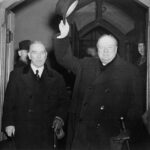 Library and Archives Canada, Public domain
Library and Archives Canada, Public domainFor most of its modern history, Britain has been firmly defined by its political independence—sometimes even defined by its resistance to unification with others. But throughout the centuries, there have been moments where the United Kingdom, or parts of it, came surprisingly close to formally merging with another nation. Whether through dynastic unions, diplomatic proposals, or strategic considerations, these episodes show just how different history could have been. Some proposals were taken seriously at the highest levels of government; others arose out of desperation, convenience, or royal marriages. In every case, Britain was closer than we might imagine to sharing a future with another power. Here are some of the most intriguing times Britain nearly joined another country.
The Anglo-French Union proposal (1940)
During the darkest days of World War II, as German forces advanced toward Paris and France teetered on the edge of surrender, an extraordinary idea emerged. French Prime Minister Paul Reynaud, hoping to rally his country’s morale and prevent capitulation, suggested a full political union with Britain. The idea was supported in principle by Winston Churchill, who saw the benefit of uniting the two nations against a common enemy.
The draft declaration proposed a single Franco-British nation with joint military command, common foreign policy, and shared citizenship. It was a dramatic gesture, but one met with resistance by the French cabinet, particularly by Marshal Pétain, who saw it as an unacceptable surrender of sovereignty. France opted to sign an armistice with Germany instead, and the union never materialised. Still, this episode stands as perhaps the closest modern example of Britain coming within hours of a total political merger with another nation.
The Kalmar Union’s ripple effect (1397)
While Britain was not a member of the Kalmar Union, the political unification of Denmark, Sweden, and Norway under a single monarch in 1397 sparked discussions elsewhere in Europe—including in England. At the time, England was navigating complex alliances, and there were exploratory talks of forming broader coalitions to counter growing powers on the continent.
One speculative idea involved a marriage alliance between King Henry IV of England and Queen Margaret I of Denmark, who ruled the Kalmar Union. Though it never progressed beyond preliminary discussion, it reflected how interconnected royal families and political interests could open the door to larger unions. These conversations show that Britain’s diplomatic focus wasn’t always confined to France or the Holy Roman Empire—it also looked north.
The Auld Alliance with Scotland and France (1295)
Established in 1295, the Auld Alliance was a military and diplomatic agreement between Scotland and France aimed at curbing English expansionism. Over time, the alliance grew into something deeper, with Scottish monarchs marrying into the French aristocracy and French troops assisting Scotland in military campaigns.
Had events played out differently—had the Union of the Crowns in 1603 not brought Scotland and England under one monarch—it’s possible Scotland might have drifted more permanently toward France. The alliance fostered strong cultural and economic ties, and some historians speculate that, under the right conditions, a formal Franco-Scottish union could have occurred. Though the alliance was officially dissolved in 1560, it left a long legacy that highlights just how close Scotland came to aligning itself with France over England.
The personal union with Hanover (1714–1837)
When Queen Anne died in 1714 without a direct Protestant heir, the British crown passed to George I, Elector of Hanover, under the terms of the Act of Settlement. This established a personal union between Britain and Hanover that would last for over a century.
While the two states remained legally distinct, the union had far-reaching implications. British monarchs frequently travelled to Hanover, influenced foreign policy decisions with Hanoverian interests in mind, and even deployed British troops to defend the territory. Discussions occasionally surfaced about deepening the relationship, especially during times of shared threat. The union ended in 1837 with the ascension of Queen Victoria, who could not inherit Hanover due to its male-only succession laws. Still, the entanglement was substantial enough that, for many decades, Britain’s political direction was partially shaped by its German ties.
The proposed union with Belgium (1830)
After the Belgian Revolution in 1830, which saw Belgium break away from the United Kingdom of the Netherlands, several European powers scrambled to shape the new country’s future. Britain had strategic interests in the region and wanted to ensure Belgium remained a neutral buffer state between France and Germany.
Some politicians in Britain proposed closer integration—either through a dynastic union or a protectorate-style relationship that would keep Belgium closely aligned with British interests. There were suggestions of marrying a British royal into the Belgian monarchy, or even of offering British military protection in exchange for long-term political influence. Ultimately, Belgium was recognised as an independent constitutional monarchy, but the prospect of a formal political union was seriously entertained in certain circles.
The Commonwealth of Britain and Ireland (1801)
With the Act of Union in 1801, Ireland was brought formally into the United Kingdom. But this legal union was always uneasy, and Ireland’s status remained contentious throughout the 19th century. During debates around Home Rule in the late 1800s, alternative proposals emerged that sought to reframe the UK as more of a confederation than a centralised state.
These proposals often envisioned a “Commonwealth” model, with Britain and Ireland as semi-autonomous but united entities—each with control over domestic affairs but sharing a federal government for defence and foreign policy. This concept resembled the federal systems seen in countries like Canada or Switzerland. Though ultimately rejected, it reflected genuine attempts to redefine union on more balanced, collaborative terms.
The entanglements of the British and Dutch crowns
In the wake of the Glorious Revolution in 1688, William of Orange—Stadtholder of the Dutch Republic—became co-monarch of England alongside his wife, Mary II. This led to a rare period where Britain and the Netherlands, two maritime and commercial giants, shared a head of state and coordinated closely on policy.
The relationship didn’t evolve into full political union, largely because the Dutch Republic maintained its decentralised, merchant-driven political system. However, there was real talk of deepening the integration, particularly among pro-trade factions in both countries. The era saw joint military operations and aligned foreign strategies, and it’s not hard to imagine that, under different circumstances, the union might have formalised into something lasting.
The flirtation with joining the European Communities (1961–1973)
Britain’s long and winding road to European integration began in earnest in the 1960s. Twice, Prime Minister Harold Macmillan’s applications to join the European Economic Community were blocked by French President Charles de Gaulle, who questioned Britain’s commitment to the European project and feared it would serve as a Trojan horse for American influence.
When Britain finally joined in 1973 under Edward Heath, it became part of a growing pan-European system that shaped everything from trade and environmental law to human rights and immigration. In the 1990s and early 2000s, there were serious discussions about Britain adopting the euro and deepening political integration. Though that didn’t happen—and Brexit would eventually sever ties—the UK did spend decades on the brink of becoming a central player in a united Europe.
The Polish-Lithuanian-British proposal (18th century)
An obscure but intriguing diplomatic idea emerged in the 18th century when Poland-Lithuania, facing decline and partition, sought potential allies in Western Europe. Some Polish nobles and British political thinkers floated the idea of creating a formal alliance or union, possibly through marriage or constitutional cooperation, to counterbalance Russian and Austrian influence.
While largely forgotten today, the correspondence from that period shows that British involvement in Eastern Europe was not entirely passive. Though no union came of it, the discussions highlighted a willingness, at least among some, to consider alliances that stretched well beyond Britain’s usual spheres of interest.
Britain has long been seen as a country that prizes its autonomy.
However, its history is peppered with moments where it seriously considered joining forces with others—sometimes temporarily, sometimes permanently. Whether through war, marriage, diplomacy, or strategic necessity, the notion of a shared future with another nation has never been off the table entirely. These examples show that history is full of almosts, and that national identity is far more fluid than it often seems. If a few decisions had gone differently, Britain’s map—and its alliances—might look very different today.



